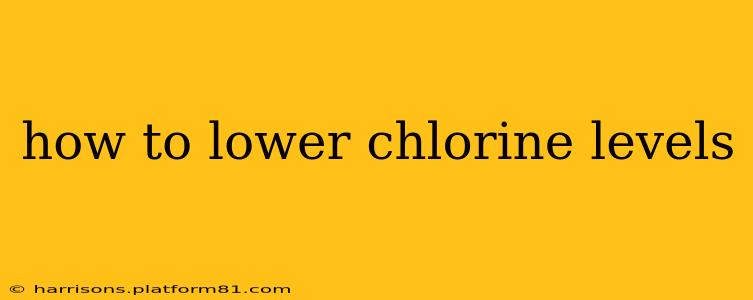Maintaining the proper chlorine levels in your swimming pool is crucial for safety and hygiene. Too much chlorine, however, can lead to irritated eyes, skin problems, and damage to your pool's equipment. Knowing how to lower chlorine levels effectively is a vital skill for any pool owner. This guide provides comprehensive steps and strategies to address high chlorine situations safely and efficiently.
Why Are My Chlorine Levels Too High?
Before diving into solutions, it's helpful to understand why your chlorine levels might be elevated. Several factors can contribute:
- Over-chlorination: Accidentally adding too much chlorine is a common culprit. Always double-check your measurements before adding any chemicals.
- Incorrect chemical balance: Imbalances in other pool chemicals like pH, alkalinity, and calcium hardness can affect chlorine levels. High pH, for instance, can cause chlorine to become less effective and potentially lead to a perceived increase in free chlorine. Conversely, low pH can also lead to rapid chlorine depletion, sometimes requiring large additions which could lead to overly high levels.
- Sunlight: UV rays from the sun can break down chlorine, but this usually leads to lower levels. However, in certain situations, particularly with heavily chlorinated water, the breakdown products can lead to a higher reading on certain test kits.
- Shock treatment: After a significant event like a storm or heavy use, you might have added a chlorine shock, resulting in temporarily high levels. This is usually temporary and requires no special intervention unless levels remain exceptionally high.
- Faulty equipment: Problems with your pool's filtration system can lead to inconsistent chemical distribution and potentially high chlorine levels in certain areas of the pool.
How to Lower Chlorine Levels in Your Pool: A Step-by-Step Guide
There are several safe and effective ways to lower chlorine levels in your pool:
1. Dilute the Chlorine: The simplest method involves adding fresh water to dilute the existing chlorine concentration. This is best for slightly elevated levels. Add fresh water gradually, testing the chlorine levels frequently to avoid over-dilution. Remember to adjust the other pool chemicals appropriately after adding fresh water.
2. Run the Pool Pump: Running your pool pump for an extended period (24-48 hours) helps circulate the water and evenly distribute the chlorine. This method is most effective when combined with other strategies. Ensure the filter is clean for optimal circulation and filtration.
3. Use a Chlorine Neutralizer: Pool supply stores offer chlorine neutralizers, often containing sodium thiosulfate. Carefully follow the product instructions, always adding the neutralizer slowly and with constant mixing to ensure even distribution. This approach is particularly suitable for significantly high chlorine levels.
4. Partial Water Drain and Replacement: In cases of severely high chlorine levels, partially draining a portion of the pool water and replacing it with fresh water can significantly lower the concentration. Remember to balance the pool chemicals again after draining and refilling. This is a more labour-intensive solution and should only be employed when other methods prove insufficient.
What Happens If Chlorine Levels Are Too Low?
This question is frequently asked and is important to address for a holistic understanding of pool maintenance. Low chlorine levels increase the risk of algae growth and bacterial contamination, making the pool unsafe for swimming. Regular testing and prompt addition of chlorine are essential to prevent low chlorine levels.
How Often Should I Test My Pool Water?
Regular testing is key to maintaining healthy chlorine levels. Aim to test your pool water at least twice a week, or more frequently during periods of heavy use or inclement weather.
What Chemicals Should I Use to Balance My Pool Water?
Beyond chlorine, maintaining proper levels of pH, alkalinity, and calcium hardness is crucial. Using a test kit to monitor these levels and adjust accordingly is essential for optimal pool water chemistry.
Can I Swim in a Pool with High Chlorine Levels?
Swimming in a pool with excessively high chlorine levels is not advisable. It can cause eye irritation, skin dryness, and other discomfort. Lower the chlorine levels before resuming swimming.
How Do I Prevent High Chlorine Levels in the Future?
Careful measuring and consistent monitoring are key. Always use a reliable test kit and follow the instructions on chemical packaging precisely. Regular pool maintenance, including proper filtration and regular chemical balancing, will significantly reduce the risk of high chlorine levels.
Remember, safety is paramount. Always wear appropriate protective gear when handling pool chemicals. If you are unsure about any aspect of pool maintenance, consult a professional pool technician.
